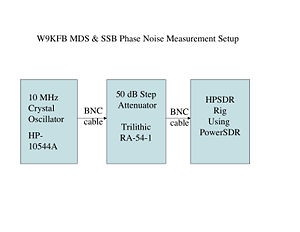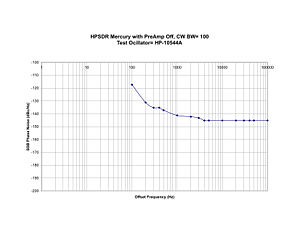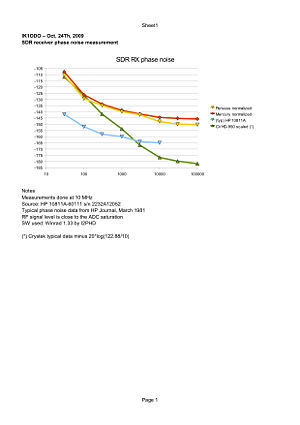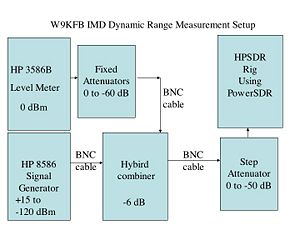Receiver Performance Tests
Contents
Instruments required
Tests
Sensitivity
The Sensitivity test is very simple to do on an HPSDR rig:
- Calibrate the level and frequency on the rig with the output of the signal generator using PowerSDR's Setup calibration at the test frequency using a -40 dBm signal.
- Set the panadapter to average the signals.
- Set the Mode to CWL, the bandwidth to 100, and the preamp to Off.
- Read the value of the noise floor with the PowerSDR meter set to "SigAvg", with the signal generator turned off. This value will be the minimum discernible signal (MDS).
- Obtain a MDS value with the preamp on at the same test frequency by repeating all the above steps.
SSB Phase Noise
The SSB Phase Noise tests require a very low phase noise oscillator to run the tests. Most synthesized oscillators will not be good enough. Before you choose an oscillator to do the testing, check its SSB phase noise specifications. If the oscillator has a worst case spec of greater than -130 dBc/Hz, find one that is better as your noise measurement results will never be better than the test oscillator noise level. Also note that in choosing a test oscillator for SSB Phase Noise measurement, 10 MHz should be avoided as there is usually a 10 MHz signal from the Mercury clock source that will interfere with measurement of SSB Phase Noise close to the 10MHz carrier signal.
- Use the MDS obtained per the process above as A0, then tune away from the signal until you can't distinguish a tone in the noise or to your first defined offset frequency. At this frequency, increase the amplitude of the signal until the displayed amplitude (using the PowerSDR meter set to "SigAvg") is the same as A0 plus 3 dB (the MDS will be a minus number, so this number will be 3 dB lower in absolute value), note the frequency f1, and then go back to f0 and measure the amplitude A1 using the PowerSDR meter set to "SigAvg".
- To calculate SSB Phase Noise use this equation from KI6WX's March and April, 1988, QST article (The 2009 and earlier ARRL Handbooks have a missing minus sign in the equation): L(f)=A1-A0-10Log(BWnoise), Where L(f)= SSB phase noise in dBc/Hz; A1= The attenuation required at the offset frequency for the same noise level as A0 plus 3 dB; A0= MDS; and BWnoise= The CW bandwidth used during the test.
Blocking Dynamic Range
The ARRL handbook instructions (Page 25.43 of the 2009 handbook) says to use a weak signal at about a level of 110 dBm and a strong signal 20 KHz offset. The ARRL Lab procedures requires the weak signal level to be about 10 dB below where we detect the 1 dB of gain compression of the weak signal. On Mercury no detectable gain compression was measured on any level of weak signal with any level of strong signal below the A/D overload values at 4, 14, and 30 MHz with the PreAmp on or off.
IMD Dynamic Range
IMD Dynamic Range measures the effect of two-tone IMD on a HPSDR receiver. IMD is the production of spurious responses that results when two or more signals mix. IMD occurs in any receiver when signals of sufficient magnitude are present. IMD Dynamic Range is the difference, in dB, between the noise floor and the strength of two equal incoming signals that produce a third-order product 3 dB above the noise floor. For more information on IMD Dynamic Range measurement, see the 2009 ARRL Handbook, Test procedures, Chapter 25, page 25.43. Important note: To get good performance with respect to the IMD Dynamic Range tests, be sure to check "Dither Enabled" and "Random Enabled" in the Setup > HPSDR > Mercury Options panel. If this is not done your IMD Dynamic Range will be reduced by about 50%. Reference:Mercury - intermodulation (IMD) tests.
Third-Order Intercept Tests
The recommended method of calculating the third-order intercept going for HPSDRs is as follows: IP3=(3*(Input Level)-(IMD Level))/2
Where IP3 is the level where the desired response and the third-order IMD would theoretically be the same, if extended beyond their linear regions (In reality these levels would be a Mercury A/D overload level... positive dBm values). The values are considered a figure of merit.
The "Input Level" is the dBm value of the two signals of equal level that provides a given third order product level.
The "IMD Level" is a target level of -97 dBm for all HPSDR receiver designs.
This file compares measurements taken at W9KFB's lab, Walter, HB9AJG's lab, and the ARRL Lab (Flex 3000 data) media:ARRL FLX3000&HB9AJG tests.pdf .




